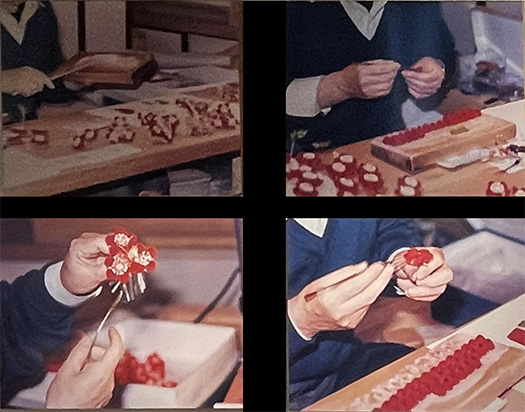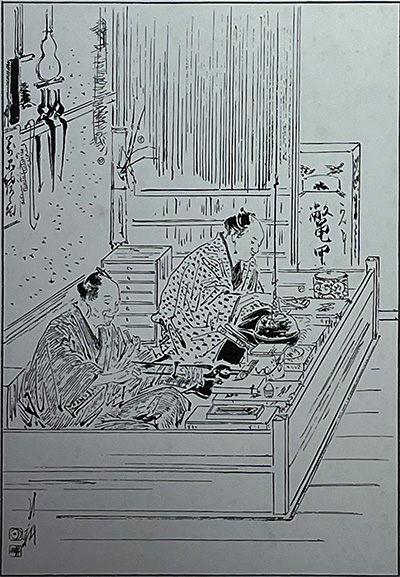

商家の町家群展示、千葉県の「房総のむら」で出会った「小間物屋」。町家建築はその時代の「消費動向」を把握できる。日本女性の美感探究のオリジナル性というのは有史以前から連綿と続いていたでしょう。一見奇妙な形態を見せる縄文土偶の一部にはそういう「髪結い」が反映されていたのかも知れない。きのう江戸期の髪結いの文化について見て改めて気付かされた。どうして日本列島社会ではこういうふうに髪結いが発展して、きわめてオリジナル性の高い髪結い習慣に発展したのか。考えて見ると日本人のナゾ。女性のファッション感覚が作り上げてきた歴史の重要なパーツだけれど、あまり考察してみたことはなかった。言ってみれば「美感の歴史」だけれど、美術作品の流れみたいなものは跡づけることができても、こういう感覚の歴史、あるいは流行の歴史というものは跡づけにくいのかも知れない。決定的なのはむしろこういう日常的な部分だろう。
個人的には娘の成人式での髪結いを思い出す。美容師さんがいろいろに髪型を考えてくれて「もっとこの辺を盛り上げましょうか」「いいね、それ」みたいなやり取りがあって、大いに盛り上がった記憶がある。やはり日本女性のDNAに触れる部分で奥深い審美眼が刺激されているように感じた。彼女たちの目の光のキラキラ感には思い出す度に微笑させられる(笑)。

こういう文化の結晶として櫛やかんざしの類は日本の工芸分野で独特の位置を占めていった。江戸期の職人図でも座っての手先作業ぶりが描かれている。手先に注意が集中する特殊な手工芸の世界。背景としての髪の色が日本民族の場合、黒が基調色になるので、赤と白がポイントカラーとして選択されてきたのだと思う。用途としては髪のデザイン造形をまとめ上げて美感を強調する役割。やはり黒い長髪で風土条件にも反応した質感というのがこの髪結い伝統の基板を形成してきたと思う。
この条件を活かしていくヘアデザインを長時間、およそ37,000年考え続けてきて、オリジナルの髪結い習慣に結晶してきたように思う。その後、明治に至って西洋文化を完全に受容したとき、和服に対して活動機能性に優れた洋服にファッションの背景条件が大変化した。このことで和の髪結い習慣は主流からは外れた。
しかしこのような手工芸の感覚世界は、その後の産業興隆の基盤になっていったと思う。日本独特のものづくり要素としてディテールへのこだわりがあるけれど、その文化風土は日本女性の黒髪が大いに関係していたという大胆な推論も可能に思う(笑)。
English version⬇
Oshare hair comb and hairpin, Edo period, Boso-machiya-6]
Japanese women have black hair. The hair quality nurtured by the climatic conditions also created a unique sense of beauty. The props and workmanship that suited the hair created the foundation for the manufacturing industry that followed.
Exhibition of a group of merchant townhouses, “komono-ya” (booth shop) encountered in the “Boso no Mura” in Chiba Prefecture. The originality of Japanese women’s search for aesthetics has probably been continuous since prehistoric times. Machiya architecture allows us to grasp the “consumption trends” of its time. Some of the seemingly strange forms of Jomon clay figurines may have reflected such “hairdressing. Yesterday, I was reminded of this when I looked at the Edo period’s hairdressing culture. I wondered why the custom of hairdressing developed in this way in the Japanese society and developed into a highly original custom. It is a puzzle for Japanese people. It is an important part of the history of women’s sense of fashion, but I have never given it much thought. It is a “history of aesthetics” in other words, but while we can trace the flow of art works, it may be difficult to trace the history of this sense or the history of fashion trends. However, what is decisive is the everyday part like this.
Personally, I recall my daughter’s hair at her coming-of-age ceremony. The hairdresser came up with various hairstyles, and there was a lively exchange of ideas such as, “Shall I make this part of her hair more lively? I felt that this was a part of Japanese women’s DNA that stimulated their deep aesthetic sense. The sparkle in their eyes makes me smile every time I recall it (laugh).
As a fruit of this culture, combs and hairpins occupied a unique position in the field of Japanese crafts. Even the Edo period craftsmen’s drawings depict the way they worked with their hands while sitting down. This is a special kind of handicraft in which attention is concentrated on the fingertips. The color of the hair as a background is black for the Japanese people, and red and white have been chosen as the point colors. The purpose of this technique is to emphasize the beauty of the hair by bringing it together in design and modeling. I believe that the texture of long black hair that responds to the climate conditions has formed the basis of this hair-tie tradition.
The hair design that makes the most of these conditions has been thought about for a long time, about 37,000 years, and has crystallized into the original custom of hairdressing. Later, when Western culture was fully embraced in the Meiji period (1868-1912), the background conditions for fashion changed drastically, with Western clothes having superior activity and functionality in contrast to Japanese clothes. This meant that the Japanese custom of tying hair fell out of the mainstream.
However, the sensory world of handicrafts became the foundation for the subsequent rise of industry. One of the unique elements of Japanese craftsmanship is the attention to detail, and it is a bold inference that the cultural climate had a lot to do with the black hair of Japanese women (laughs).
Posted on 1月 13th, 2023 by 三木 奎吾
Filed under: 未分類







コメントを投稿
「※誹謗中傷や、悪意のある書き込み、営利目的などのコメントを防ぐために、投稿された全てのコメントは一時的に保留されますのでご了承ください。」
You must be logged in to post a comment.